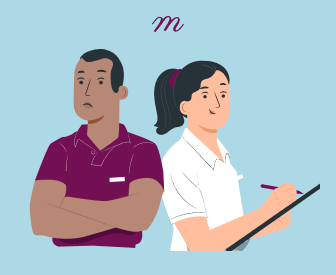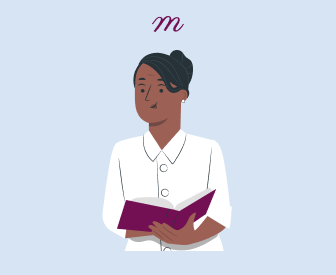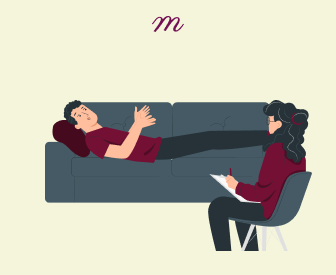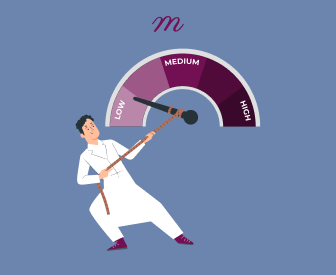Have your progress notes written for you automatically
Clients in therapy display a wide variety of emotions and behaviours, and some may even pose particular “difficulties”. “Difficult” can refer to a variety of things. These are clients who remain aloof and quiet in the sessions, overly chatty, unwilling to participate, or even hostile and aggressive might be considered challenging.
Such behaviours presented by the client might put a therapist’s tolerance and flexibility to test. However, these difficulties often signal anxiety, underlying fears, past traumatic experiences, or innate self-defence mechanisms. Therapists might treat these responses as chances to develop genuine relationships and trust rather than as challenges. By using empathy, and using the appropriate interventions, therapists can transform difficult interactions into valuable moments of growth and connection.
Most Common Kinds of Difficult Client in a Therapy Session
1. Externalisers
Externalising clients are those who shift the ownership and accountability of their struggles to something/someone outside of themselves. They may often provide excuses or blame others for their lack of success. For example –
Client: “I haven’t been able to apply for jobs because my parents keep putting pressure on me. And with all the stuff going on in the world – it’s just impossible.”
Therapist: “I hear you. It must feel like a lot of pressure. Let’s focus on what you can control, and see if there is anything you feel ready to do.”
Confronting the clients on their externalizers can often escalate their resistance. A better approach is to validate their feelings and gently redirect them to explore what steps they can take, as shown in this example above.
2. Silent Clients
Silent resistance is more passive but no less difficult. These clients may refuse to respond or will avoid responding at all during the session. For example –
Therapist: “How have you been feeling since we last spoke?”
Client: (silent or reply “fine“).
During these times a therapist may need to use open ended questions and provide subtle encouragement, in hopes to facilitate a potential client response. One method is to encourage reflection on the past session: “I noticed last time that you were quieter than usual. Could we explore what was on your mind?”.
3. Confrontational Clients
Confrontational clients may be hostile or aggressive during the sessions. They might question our methods or even our competence as a therapist. For example, a client might say:
‘I don’t even know why I’m here. I don’t think these sessions work—are you really going to tell me what’s wrong with me?’
When a therapist comes across such a kind of resistance, it’s important to acknowledge the client’s frustration rather than dismiss it. Recognizing and validating their emotions can help de-escalate tension in the relationship dynamic. Setting clear boundaries and having an open conversation about their concerns can also rebuild trust and keep the therapeutic relationship on track.
A helpful response could be:
‘It sounds like you’re feeling frustrated with this process, and I appreciate you sharing that. Let’s take a moment to explore what’s not working for you and how we can move forward together.
4. Defensive Clients
These types of clients are resistant to therapy in a way that they have a big wall that is trying to protect them. They have defenses in places to avoid hurt/vulnerability. It might manifest in numerous ways – denial, minimising, rationalizing, intellectualising, etc. Here, the therapist’s task is to navigate through the defensiveness without pushing too hard. Creating a non-judgmental space for open dialogue is essential for breaking through these walls. One way to go about it could be –
Client: “I don’t really need therapy. I am absolutely okay. I’m just here because my boyfriend wants me to attend these sessions.”
Therapist: “I understand that you’re not feeling the need for therapy. Sometimes it takes time to see the value of the process. Would you be open to talking about what brought you here today?”
5. Overly Dependent Clients
This type of resistance can appear less like opposition and more like an over-reliance on the therapist for direction or validation. An example of this might be:
Client: “I don’t know what I’d do without you. Can you tell me what I should do next in my life?”
Therapist: “I’m glad you trust me. Part of this process will be helping you explore your own strengths and finding the answers within yourself.”
In working with dependent clients, it’s crucial for therapists to gradually shift the responsibility back onto the client, encouraging independence while maintaining support. Building self-reliance and setting healthy boundaries are key elements of the work.
Effective Techniques
1. Stay Calm and Present
One of the first things a therapist can do when confronting difficult clients is to regulate our own emotional state. As therapists, we are often the emotional reference point in the session. Obviously we do not want to escalate the situation with reactivity. The therapist in fact helps the client co-regulate. Mindfulness and self-awareness are crucial skills needed to ensure we do not respond impulsively to a challenging client.
It’s perfectly acceptable to ask for a moment of silence to regulate yourself if needed. The calmer you feel, the easier for you to respond in a calm and constructive response. For example, if a client is expressing their anger about therapy not being helpful and if the therapist gets angry too then it might turn into an hostile equation thereby causing a rupture in the alliance. The therapist can ask for a minute and come back to the session with a calm presence that will help the client co-regulate as well.
2. Express Empathy and Validation
The key ingredient to dealing with the difficult client is empathy. Validate the client’s experiences without judgment. For example: If a client is frustrated, you might say, “I can hear that you’re frustrated with how things are going”. This exercises validation and allows the client to feel heard. This ensures that the client’s feelings are normalised.
As therapists we can make sure our empathy is genuine. While the phrase “I understand” is useful, overusing this terminology sounds mechanical and unproductive especially when dealing with difficult clients.
3. Understand the Client’s Resistance
Clients that appear resistant or difficult to work with are usually communicating fears or discomfort. Working with them with patience and real interest is essential. They may have learned to defend themselves by evading situations, becoming passive, or pulling back emotionally because of past trauma or difficult life circumstances. It is best that therapists don’t push too intensely since it may not be effective. At times, stepping back instead of escalating the strategy can make the client feel safer.
Techniques like open-ended questioning or writing or drawing assignments might help clients communicate in a less intimidating way. Additionally, it could be simpler to discuss with a client what they want to talk about in therapy rather than just their feelings or concerns, this will make it easier to build rapport. For instance, talking about a pet, hobbies, friends, or interests might be utilized as a way to build rapport before talking about more sensitive topics if the adolescent is unwilling to express their concern.
4. Set Clear Expectations
It is important to set realistic expectations at the beginning of the therapeutic relationship. Some clients may come in with preconceived notions about what therapy will look like based on previous personal experience or experiences of others.
Being transparent about what therapy can and cannot do will help therapists handle these expectations. Inform clients that therapy is a process rather than a quick fix and that transformation requires time and effort. Examining prior treatment experiences might be beneficial when working with clients who have high expectations. This might highlight differences in the theoretical approach and might help you and the client better understand the client’s needs.
5. Address Emotional Barriers
People who have been through trauma often bring those experiences into therapy, and it can affect how they engage in sessions. For example, someone who went through childhood abandonment may struggle with trust in their relationships, which can also make it difficult for them to open up in therapy. Recognizing these patterns is essential for therapists to provide the right support.
Building trust starts with creating a safe, judgment-free space where clients feel accepted. It also helps to explain common trauma responses—like fight, flight, or freeze—so clients can better understand their reactions. When they see these responses as normal rather than something to be ashamed of, it can make processing emotions feel more manageable.
6. Use Alternate Expressive Techniques
For a client who is resistant or avoidant, talking about feelings directly may be too much at times. In such cases, creative and expressive tools can be useful replacements. Drawing, writing or role-playing can facilitate self-expression in a less threatening manner. Let us consider a client who has a hard time expressing emotions may be able to express their thoughts in some art or story. They allow expression, and give the therapist a window into the client’s internal world without pressure to put it into verbal language.
7. Seek Support and Supervision
Managing difficult clients can be emotionally draining for therapists. Recognizing when you need support and seeking supervision is crucial in mental health work. Connecting with peers or supervisors can offer fresh and new perspectives and help process the complex emotions that come up in sessions. Having this support system not only helps therapists maintain professionalism and prevent burnout but also enhances their effectiveness in the long run. Time to time supervision can help a therapist identify their own patterns when engaged with a difficult client which might create space for some level of personal work as well.
Difficult Clients in Group Therapy
Managing difficult clients is obviously difficult but managing difficult clients in a group setting is harder. Group dynamic brings forth multiple personalities and subsequent interactions. Difficult clients in a group setting can present themselves in the following forms.
1. The Silent Observer
You will notice that these clients are not contributing to the discussions. This might be arising from either their anxiety, unfamiliarity or disinterest. A therapist can tackle such clients by trying out the following –
- Gentle invitations: “Arjun, I noticed you’ve been listening carefully. Would you like to tell us what is the one thing that stood out to you today?”
- Encourage small participation (build it gradually): “Aisha, you don’t have to share a big summary, but could you sum up how you’re feeling in one emotional word?”
- Pair them with a peer: Assigning a more talkative and active member to check in with them outside the group can increase comfort.
2. The Latecomer
Clients who consistently arrive late can break the flow of the session and might disrupt the members’ focus . A therapist can try to –
- Acknowledge the pattern honestly: “Raj, I noticed you’ve been coming in after we’ve started. Let’s talk about what might help you get here on time.”
- Encourage group reflection with compassion: “How does it affect everyone when someone joins late? What could help us maintain focus?”
- Set clear expectations: If lateness persists, remind them of group norms and the importance of punctuality.
3. The Dominator
Some clients monopolize discussions, preventing quieter members from contributing. They may not realize the impact of their behavior. The therapist can try to work with such clients –
- Gently redirect them: “Vikram, I appreciate your insights. Let’s pause and hear from someone who hasn’t shared yet.”
- Use time-sharing method: Allocate a set amount of time per person or encourage members to use a “talking object” to signal when it’s their turn.
- Privately check in: If the issue persists, a one-on-one discussion can help them become more aware of their role in the group.
4. The Confrontational Client
Some clients challenge the therapist, and the group process, or instigate conflicts. The therapist can work around this by –
- Validate emotions without engaging in conflict: “I hear that you’re frustrated. Can we explore what’s feeling difficult for you in this space?”
- Encourage self-reflection: “What would need to change for this experience to feel more useful to you?”
- Set firm boundaries: If hostility continues, reinforce group norms and remind them that respectful communication is essential.
5. The Overly Analytical Client
These clients act as “mini-therapists,” offering advice rather than focusing on their own experiences. While well-intended, their behavior can make others feel judged or pressured.
How to Respond:
- Refocus on personal reflection: “Neha, your insights are valuable. What’s something from today’s discussion that resonates with you personally?”
- Encourage peer input: “Before we discuss solutions, let’s hear how others feel about this situation.”
- Gently address the behavior in private: If needed, have a one-on-one conversation about the importance of balancing advice-giving with self-reflection.
6. The Resistant Client
Some clients attend therapy reluctantly (due to a court order, employer, or family pressure) and may resist participation.
How to Respond:
- Acknowledge their frustration: “I understand that being here wasn’t your choice. Since you’re here, what’s one thing that could make this experience worthwhile?”
- Encourage group engagement: “Has anyone else felt hesitant about therapy? What helped you open up?”
- Avoid power struggles: Rather than pushing them to engage, allow them space to participate at their own pace.
General Strategies for Managing Difficult Clients in Groups
- Encourage members of the group to share their opinions and thoughts on unhelpful behaviours by one of the difficult client, which can sometimes be more impactful than direct intervention from the therapist.
- Establish ground rules about the group therapy session – respect, and punctuality can be inculcated from the start
- Some clients need firm boundaries, while others respond better to gentle encouragement. Adjust your approach accordingly based on your rapport and the client’s personality.
- Stay calm and non-defensive when clients challenge or frustrate you, reinforcing a dynamic of respectful communication.
- Managing difficult clients can be emotionally draining. Consulting with peers or supervisors can offer new perspectives and prevent burnout.
Conclusion
Handling difficult clients in therapy requires empathy, and an understanding of the underlying emotional obstacles that are contributing to their resistance. Whether a client externalizes their struggles, remains silent, becomes overly-confrontational, or is very dependent, each behavior presents an opportunity for meaningful therapeutic work.
By validating client’s emotions, setting clear expectations of therapeutic work, and incorporating creative therapeutic techniques, therapists can foster a safe and nurturing environment. Ultimately, difficult clients are not obstacles but individuals in need of deeper connection and understanding. With the right approach, even the most challenging sessions can lead to profound growth and healing for both the client and the therapist.









